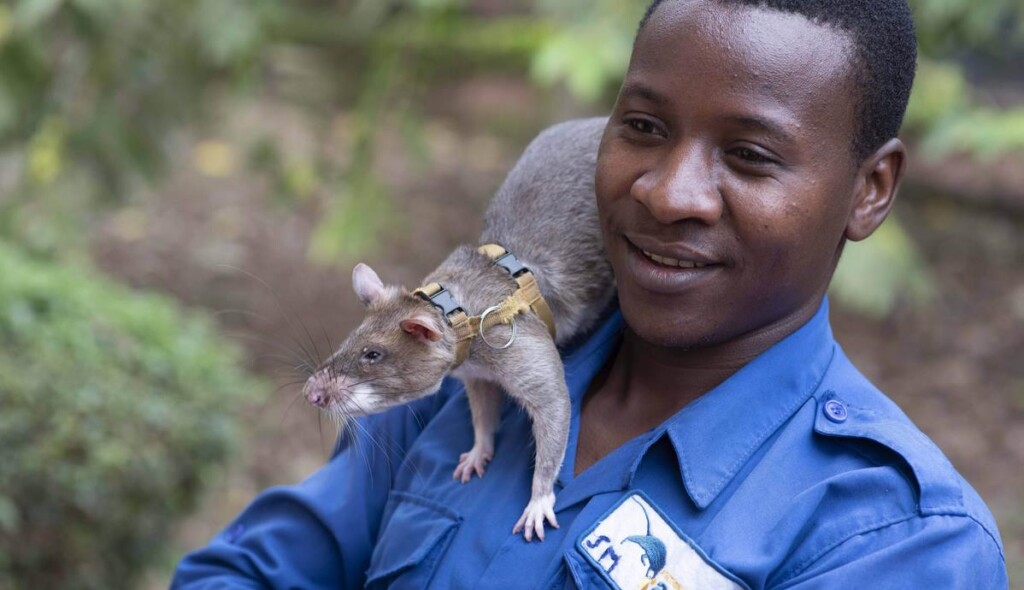In East Africa, Rats Have Prevented 400,000 New Cases of Deadliest Infection Using Their Super Sense of Smell

For most people, a rat is at best an unwelcome guest, and at worst, the target of immediate extermination. But in a field clinic in Tanzania, rats are colleagues—heroes even.
Far from a trash bin-dwelling NYC street rat, the African giant pouched rat is docile, intelligent, easier to train than some dogs, and for East Africans, the performer of lifesaving tuberculosis diagnoses every day.
400,000 new cases of tuberculosis (TB) were estimated to have been prevented by these rats, whose sense of smell would make a bloodhound take notice. As the number-one killer among infectious diseases worldwide, many of those 400,000 can be translated into lives saved.
“Not only are we saving people’s lives, but we’re also changing these perspectives and raising awareness and appreciation for something as lowly as a rat,” said Cindy Fast, a behavioral neuroscientist who coaches the rodents for the nonprofit APOPO.
“Because our rats are our colleagues, and we really do see them as heroes.”
APOPO uses giant pouched rates to sniff out traces of TB in the saliva of patients. In parts of Tanzania, a saliva smear test under a microscope by a human may only be 20-40% effective at detecting TB.
By contrast, a giant pouched rat like Ms. Carolina, a now-retired service rat who worked for APOPO for 7 years, raised the rates of detection on TB samples by 40% in the clinic where she worked.
It would take 4 days for scientists to analyze the number of samples that Carolina could screen in 20 minutes. For that reason, when Carolina retired last November, a party was thrown at the clinic in her honor, and she was given a cake.
TB is sometimes thought of as a thing of the past—a disease for which doctors used to prescribe “dry air,” leading modern humors to muse at the antiquated, pre-antibiotic medical advice.
But it remains the number-one cause of death globally from a single infectious pathogen, and Tefera Agizew, a physician and APOPO’s head of tuberculosis, told National Geographic that once people see what the nonprofit’s rodents can do to slow the spread, they “fall in love with them.”
MORE SNIFFER ANIMALS: Rats With Tiny Backpacks Being Used to Sniff Out Wildlife Smugglers Trafficking in Animal Parts
3,000 times in her career did Carolina detect one of the six volatile compounds that can be used to identify Mycobacterium tuberculosis, and she got a hero’s send off to a special compound to live out the rest of her days with her closet friend and sniffer colleague Gilbert, in a shaded enclosure dubbed “Rat Florida.”
“We’ve made special little rat-friendly carrot cakes with little peanuts and things on it that the rat would enjoy,” Fast said. “Then we all stand around and we clap, and we give three cheers, hip hip hooray for the hero, and celebrate together. It’s really a touching moment.”
APOPO has made headlines for its use of these rats in other lifesaving tasks as well: landmine clearance.
LANDMINE CLEARENCE WITH DRONES: Drones Find Dozens of Landmines Littering Ukraine So They Can Be Defused
One of the world’s great underreported scourges (a lot like TB, coincidentally) is landmine contamination. There are 110 million landmines or unexploded bombs in the ground right now in about 67 countries, covering thousands of square miles in potential danger. Thousands of civilians are killed or injured by these weapons every year.
GNN reported on APOPO’s demining efforts using pouched rats back in 2020. One rat named Magawa alone identified 39 landmines and 28 items of unexploded ordnance across an area the size of 20 football fields.
If at the start of this story you didn’t like rats, maybe Magawa and Carolina will have changed your mind.
SHARE This Truly Incredible And Lifesaving Work With Your Friends…
>read more at © GoodNews
Views: 0